Selective Detection of Penicillin G Antibiotic in Milk by Molecularly Imprinted Polymer-Based Plasmonic SPR Sensor
Abstract
:1. Introduction
2. Materials and Methods
2.1. Materials and Instruments
2.2. Synthesis of Silver Nanoparticles
2.3. Preparation of Nanosensors
2.4. Characterization of SPR Sensors
2.5. Kinetic Analyzes of Sensors
2.6. Determination of Selectivity and Imprinting Efficiency
3. Results and Discussion
3.1. Characterization of SPR Sensors
3.2. Kinetic Analyses of SPR Sensors
3.3. Reusability Studies of NpMIP SPR Sensor
3.4. Selectivity Studies of NpMIP SPR Sensor
3.5. The Effect of Silver Nanoparticles on Signal Enhancement
3.6. The Determination of PEN-G from Milk Sample
4. Conclusions
Supplementary Materials
Author Contributions
Funding
Institutional Review Board Statement
Informed Consent Statement
Data Availability Statement
Conflicts of Interest
References
- Türkmen, D.; Bakhshpour, M.; Göktürk, I.; Aşır, S.; Yılmaz, F.; Denizli, A. Selective Dopamine Detection by SPR Sensor Signal Amplification Using Gold Nanoparticles. New J. Chem. 2021, 45, 18296–18306. [Google Scholar] [CrossRef]
- Saylan, Y.; Akgönüllü, S.; Denizli, A. Plasmonic Sensors for Monitoring Biological and Chemical Threat Agents. Biosensors 2020, 10, 142. [Google Scholar] [CrossRef]
- Saylan, Y.; Erdem, Ö.; Inci, F.; Denizli, A. Advances in Biomimetic Systems for Molecular Recognition and Biosensing. Biomimetics 2020, 5, 20. [Google Scholar] [CrossRef] [PubMed]
- Safran, V.; Göktürk, I.; Derazshamshir, A.; Yılmaz, F.; Sağlam, N.; Denizli, A. Rapid Sensing of Cu+2 in Water and Biological Samples by Sensitive Molecularly Imprinted Based Plasmonic Biosensor. Microchem. J. 2019, 148, 141–150. [Google Scholar] [CrossRef]
- Poghossian, A.; Abouzara, M.H.; Razavi, A.; Bäcker, M.; Bijnens, N.; Williams, O.A.; Haenen, K.; Moritz, W.; Wagner, P.; Schöning, M.J. Nanocrystalline-diamond thin films with high pH and penicillin sensitivity prepared on a capacitive Si–SiO2 structure. Electrochim. Acta 2009, 54, 5981–5985. [Google Scholar] [CrossRef]
- Saylan, Y.; Denizli, A. Fundamentals and Applications of Molecularly Imprinted Systems. In Molecular Imprinting for Nanosensors and other Sensing Applications; Denizli, A., Ed.; Elsevier: Amsterdam, The Netherlands, 2021; pp. 1–17. [Google Scholar]
- Erdoğan, Ö. Molecularly Imprinted Electrochemical Sensors and Their Applications. In Molecular Imprinting for Nanosensors and other Sensing Applications; Denizli, A., Ed.; Elsevier: Amsterdam, The Netherlands, 2021; pp. 203–221. [Google Scholar]
- Idil, N.; Bakhshpour, M.; Perçin, I.; Mattiasson, B.; Denizli, A. Molecular Imprinting-Based Sensing Platforms for Recognition of Microorganisms. In Molecular Imprinting for Nanosensors and Other Sensing Applications; Denizli, A., Ed.; Elsevier: Amsterdam, The Netherlands, 2021; pp. 255–281. [Google Scholar]
- Idil, N.; Bakhshpour, M.; Aslıyüce, S.; Denizli, A.; Mattiasson, B. A Plasmonic Sensing Platform Based on Molecularly Imprinted Polymers for Medical Applications. In Plasmonic Sensors and their Applications; Denizli, A., Ed.; Wiley-VCH GmbH: Weinheim, Germany, 2021; pp. 87–102. [Google Scholar]
- Akgönüllü, S.; Saylan, Y.; Bereli, N.; Türkmen, D.; Yavuz, H.; Denizli, A. Plasmonic Sensors for Detection of Chemical and Biological Warfare Agents. In Plasmonic Sensors and their Applications; Denizli, A., Ed.; Wiley-VCH GmbH: Weinheim, Germany, 2021; pp. 71–85. [Google Scholar]
- Asir, S.; Bakhshpour, M.; Unal, S.; Denizli, A. Chapter Fourteen-Nanoparticle-based plasmonic devices for bacteria and virus recognition. In Modern Practical Healthcare Issues in Biomedical Instrumentation; Ozsahin, D.U., Ozsahin, I., Eds.; Academic Press: Cambridge, MA, USA, 2022; pp. 167–183. [Google Scholar]
- Lee, A.-Y.; Ha, N.-R.; Jung, I.-P.; Kim, S.-H.; Kim, A.-R.; Yoon, M.-Y. Development of a ssDNA aptamer for detection of residual benzylpenicillin. Anal. Biochem. 2017, 531, 1–7. [Google Scholar] [CrossRef] [PubMed]
- Piñero, M.-Y.; Bauza, R.; Arce, L.; Valcárcel, M. Determination of penicillins in milk of animal origin by capillary electrophoresis: Is sample treatment the bottleneck for routine laboratories? Talanta 2014, 119, 75–82. [Google Scholar] [CrossRef]
- BelBruno, J.J. Molecularly Imprinted Polymers. Chem. Rev. 2019, 119, 94–119. [Google Scholar] [CrossRef]
- Janczura, M.; Luliński, P.; Sobiech, M. Imprinting Technology for Effective Sorbent Fabrication: Current State-of-Art and Future Prospects. Materials 2021, 14, 1850. [Google Scholar] [CrossRef]
- Leibl, N.; Haupt, K.; Gonzato, C.; Duma, L. Molecularly Imprinted Polymers for Chemical Sensing: A Tutorial Review. Chemosensors 2021, 9, 123. [Google Scholar] [CrossRef]
- Ramanavicius, S.; Jagminas, A.; Ramanavicius, A. Advances in Molecularly Imprinted Polymers Based Affinity Sensors (Review). Polymers 2021, 13, 974. [Google Scholar] [CrossRef]
- Faalnouri, S.; Çimen, D.; Bereli, N.; Denizli, A. Surface plasmon resonance nanosensors for detecting amoxicillin in milk samples with amoxicillin imprinted poly(hydroxyethylmethacrylate-N-methacryloyl-(L)-glutamicacid). Chemistryselect 2020, 5, 4761–4769. [Google Scholar] [CrossRef]
- Ramanavicius, S.; Ramanavicius, A. Conducting polymers in the design of biosensors and biofuel cells. Polymers 2021, 13, 49. [Google Scholar] [CrossRef]
- Jamieson, O.; Mecozzi, F.; Crapnell, R.D.; Battell, W.; Hudson, A.; Novakovic, K.; Sachdeva, A.; Confarotta, F.; Herdes, C.; Banks, C.E.; et al. Approaches to the rational design of molecularly imprinted polymers developed for the selective extraction and detection of antibiotics in environmental and food samples. Phys. Status Solidi A 2021, 218, 2100021. [Google Scholar] [CrossRef]
- Lorenzo, A.; Carro, A.M.; Alvarez-Lorenzo, C.; Concheiro, A. To Remove or Not to Remove? The Challenge of Extracting the Template to Make the Cavities Available in Molecularly Imprinted Polymers (MIPs). Int. J. Mol. Sci. 2011, 12, 4327–4347. [Google Scholar] [CrossRef] [Green Version]
- Kharewal, T.; Verma, N.; Gahlaut, A.; Hooda, V. Biosensors for penicillin quantification: A comprehensive review. Biotechnol. Lett. 2020, 42, 1829–1846. [Google Scholar] [CrossRef] [PubMed]
- Gupta, B.D.; Shrivastav, A.M.; Usha, S.P. Surface Plasmon Resonance-Based Fiber Optic Sensors Utilizing Molecular Imprinting. Sensors. 2016, 16, 1381. [Google Scholar] [CrossRef] [PubMed] [Green Version]
- Ahmad, O.S.; Bedwell, T.S.; Esen, C.; Garcia-Cruz, A.; Piletsky, S.A. Sample Preparation Using Molecularly Imprinted Polymers. Trends Biotechnol. 2019, 37, 294–309. [Google Scholar] [CrossRef] [PubMed]
- Nagraik, R.; Sharma, A.; Kumar, D.; Chawla, P.; Kumar, A.P. Milk adulterant detection: Conventional and biosensor based approaches: A review. Sens. Bio-Sens. Res. 2021, 33, 100433. [Google Scholar] [CrossRef]
- Chen, B.; Ma, M.; Su, X. An amperometric penicillin biosensor with enhanced sensitivity based on co-immobilization of carbon nanotubes, hematein, and β-lactamase on glassy carbon electrode. Anal. Chim. Acta 2010, 674, 89–95. [Google Scholar] [CrossRef] [PubMed]
- Nagel, O.G.; Beltrán, M.C.; Molina, M.P.; Althaus, R.L. Novel microbiological system for antibiotic detection in ovine milk. Small Rumin. Res. 2012, 102, 26–31. [Google Scholar] [CrossRef]
- Woodward, K.N. (Ed.) Maximum Residue Limits. In Veterinary Pharmacovigilance; Wiley: Hoboken, NJ, USA, 2009; p. 547. [Google Scholar]
- Tarannum, N.; Khatoon, S.; Dzantiev, B.B. Perspective and application of molecular imprinting approach for antibiotic detection in food and environmental samples: A critical review. J. Food Control 2020, 118, 107381. [Google Scholar] [CrossRef]
- Majdinasab, M.; Mishra, R.K.; Tang, X.; Marty, J.L. Detection of antibiotics in food: New achievements in the development of biosensors. Trends Analyt. Chem. 2020, 127, 115883. [Google Scholar] [CrossRef]
- Bacanlı, M.; Başaran, N. Importance of antibiotic residues in animal food. Food Chem. Toxicol. 2019, 125, 462–466. [Google Scholar] [CrossRef]
- Royen, G.V.; Dubruel, P.; Weyenberg, S.V.; Daeseleire, E. Evaluation and validation of the use of a molecularly imprinted polymer coupled to LC–MS for benzylpenicillin determination in meat samples. J. Chrom. B 2016, 1025, 48–56. [Google Scholar] [CrossRef] [PubMed]
- Martínez-Huelamo, M.; Jiménez-Gámez, E.; Hermo, M.P.; Barrón, D.; Barbosa, J. Determination of penicillins in milk using LC-UV, LC-MS and LC-MS/MS. J. Sep. Sci. 2009, 32, 2385–2393. [Google Scholar] [CrossRef]
- Ibrahim, F.A.; Nasr, J.J.M. Direct determination of ampicillin and amoxicillin residues in food samples after aqueous SDS extraction by micellar liquid chromatography with UV detection. Anal. Methods 2014, 6, 1523. [Google Scholar] [CrossRef]
- Huang, Z.; Pan, X.-D.; Huang, B.-F.; Xu, J.-J.; Wang, M.-L.; Ren, Y.-P. Determination of 15 β-lactam antibiotics in pork muscle by matrix solid-phase dispersion extraction (MSPD) and ultra-high pressure liquid chromatography tandem mass spectrometry. Food Control 2016, 66, 145–150. [Google Scholar] [CrossRef]
- Pollap, A.; Kochana, J. Electrochemical Immunosensors for Antibiotic Detection. Biosensors 2019, 9, 61. [Google Scholar] [CrossRef] [PubMed] [Green Version]
- Pennacchio, A.; Varriale, A.; Scala, A.; Marzullo, V.M.; Staiano, M.; D’Auria, S. A novel fluorescence polarization assay for determination of penicillin G in milk. Food Chem. 2016, 190, 381–385. [Google Scholar] [CrossRef] [PubMed]
- Wang, H.; Wang, L.; Xiu, Y.; Zhang, S.; Wang, S.; Niu, X. Penicillin biosensor based on rhombus-shaped porous carbon/hematoxylin/penicillinase. J. Food Sci. 2021, 86, 3505–3516. [Google Scholar] [CrossRef]
- Baezzat, M.R.; Pourghobadi, Z.; Pourghobadi, R. Nanomolar determination of Penicillin G potassium (PGK) salt using a Carbon Paste Electrode modified with TiO2 nano particles /Ionic Liquids in real samples. Mater. Chem. Phys. 2021, 270, 124641. [Google Scholar] [CrossRef]
- Turkevich, J.; Stevenson, P.C.; Hiller, J. A study of the nucleation and growth processes in the synthesis of colloidal gold. Discuss. Faraday Soc. 1951, 11, 55. [Google Scholar] [CrossRef]
- Liu, X.; Atwater, M.; Wang, J.; Huo, Q. Extinction coefficient of gold nanoparticles with different sizes and different capping ligands. Colloids Surf. B 2007, 58, 3–7. [Google Scholar] [CrossRef] [PubMed]
- Safran, V.; Göktürk, I.; Bakhshpour, M.; Yılmaz, F.; Denizli, A. Development of Molecularly Imprinted Polymer-Based Optical Sensor for the Sensitive Penicillin G Detection in Milk. ChemistrySelect 2021, 6, 11865–11875. [Google Scholar] [CrossRef]
- Bakhshpour, M.; Denizli, A. Highly sensitive detection of Cd(II) ions using ion-imprinted surface plasmon resonance sensors. Microchem. J. 2020, 159, 105572. [Google Scholar] [CrossRef]
- Santos, L.; Ramos, F. Analytical strategies for the detection and quantification of antibiotic residues in aquaculture fishes: A review. Trends Food Sci. Technol. 2016, 52, 16–30. [Google Scholar] [CrossRef]
- Ahmed, S.; Ning, J.; Cheng, G.; Ahmad, I.; Li, J.; Mingyue, L.; Qu, W.; Iqbal, M.; Shabbir, M.A.B.; Yuan, Z. Receptor-based screening assays for the detection of antibiotics residues—A review. Talanta 2017, 166, 176–186. [Google Scholar] [PubMed]
- Rahman, M.M.; Asiri, A.M. Development of Penicillin G biosensor based on Penicillinase enzymes immobilized onto bio-chips. Biomed. Microdevices 2015, 17, 9. [Google Scholar] [CrossRef]
- Poghossian, A.; Jablonski, M.; Koch, C.; Bronder, T.S.; Rolka, D.; Wege, C.; Schöning, M.J. Field-effect biosensor using virus particles as scaffolds for enzyme immobilization. Biosens. Bioelectron. 2018, 110, 168–174. [Google Scholar]
- Mohammad-Razdari, A.; Ghasemi-Varnamkhasti, M.; Izadi, Z.; Ensafi, A.A.; Rostami, S.; Siadat, M. An impedimetric aptasensor for ultrasensitive detection of Penicillin G based on the use of reduced graphene oxide and gold nanoparticles. Microchim. Acta 2019, 186, 372. [Google Scholar] [CrossRef] [PubMed]
- Wang, L.; Xiu, Y.; Han, B.; Liu, L.; Niu, X.; Wang, H. Magnetic mesoporous carbon material based electrochemical sensor for rapid detection of penicillin sodium in milk. J. Food Sci. 2020, 85, 2435–2442. [Google Scholar] [CrossRef]
- Aghamirzaei, M.; Khiabani, M.S.; Hamishehkar, H.; Mokarram, R.R.; Amjadi, M. Plasmonic Sensor for Detection of β-Lactam Antibiotics based on the Conjugated Antibody with Gold Nanoparticles. J. Appl. Spectrosc. 2021, 88, 233–241. [Google Scholar] [CrossRef]
- Welden, R.; Jablonski, M.; Wege, C.; Keusgen, M.; Wagner, P.H.; Wagner, T.; Schöning, M.J. Light-Addressable Actuator-Sensor Platform for Monitoring and Manipulation of pH Gradients in Microfluidics: A Case Study with the Enzyme Penicillinase. Biosensors 2021, 11, 171. [Google Scholar] [CrossRef] [PubMed]
- WHO. Technical Report Series No. 430. 1969. Available online: https://apps.who.int/iris/handle/10665/40752 (accessed on 2 December 2021).
- Sila, J.M.; Guto, P.M.; Michira, I.N.; Mwaura, F.B.; Muge, E.K. Electrochemical Determination of Penicillin G in Cow Milk and pharmaceuticals in SDS/Acetate buffer. Int. J. Electrochem. Sci. 2021, 16, 210444. [Google Scholar] [CrossRef]
- Muhammad, A.; Yusof, N.A.; Hajian, R.; Abdullah, J. Construction of an Electrochemical Sensor Based on Carbon Nanotubes/Gold Nanoparticles for Trace Determination of Amoxicillin in Bovine Milk. Sensors 2016, 16, 56. [Google Scholar] [CrossRef] [Green Version]
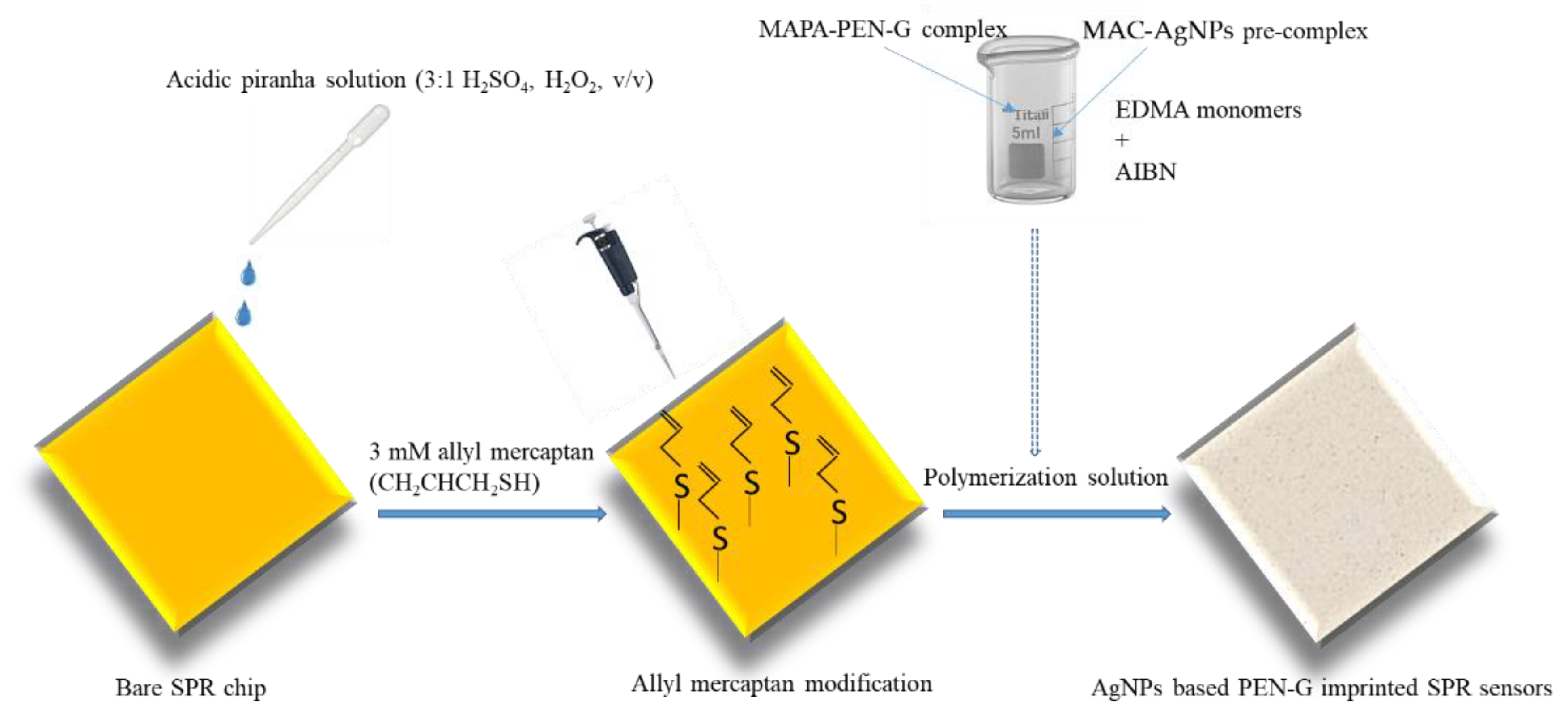
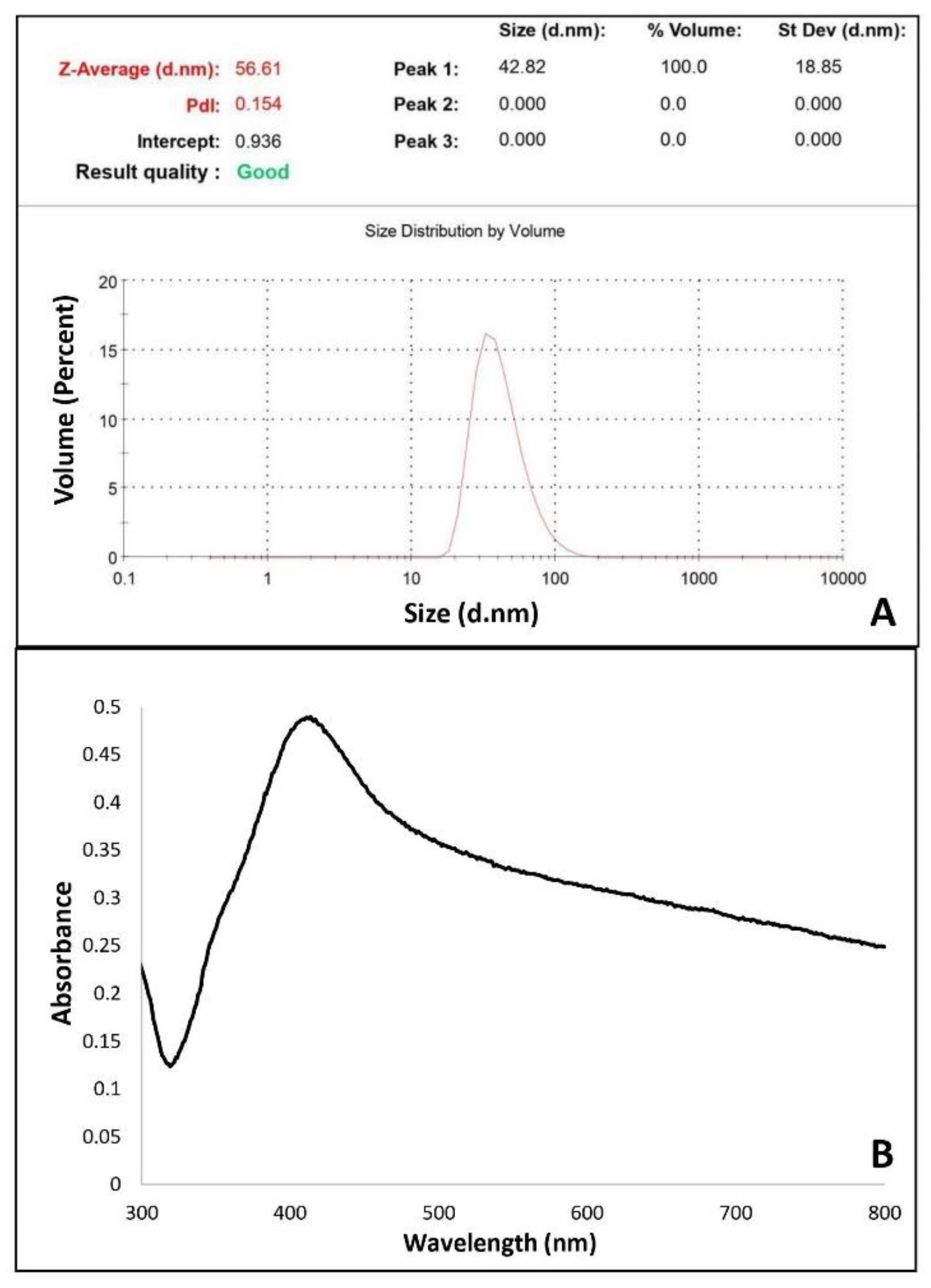

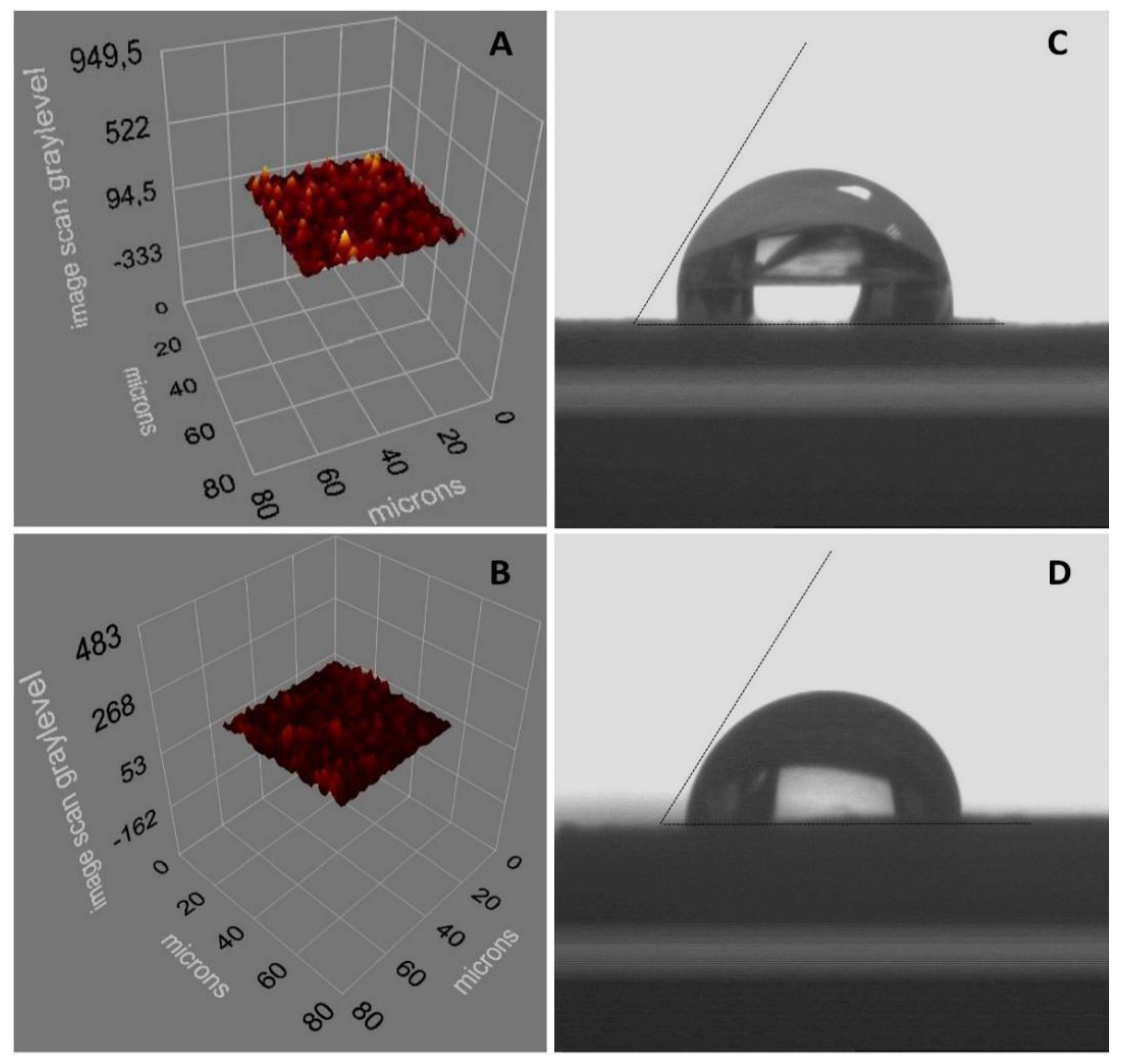
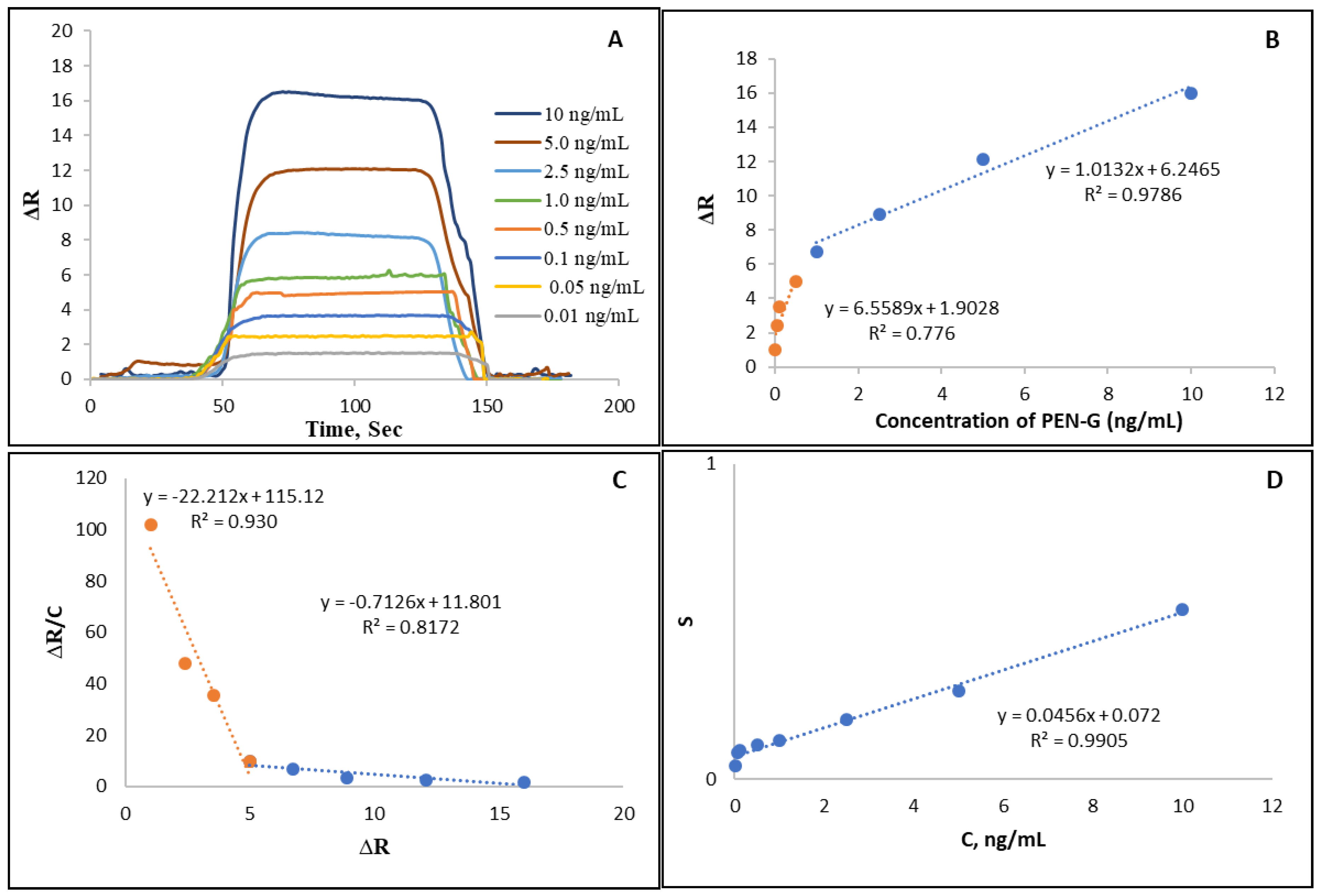


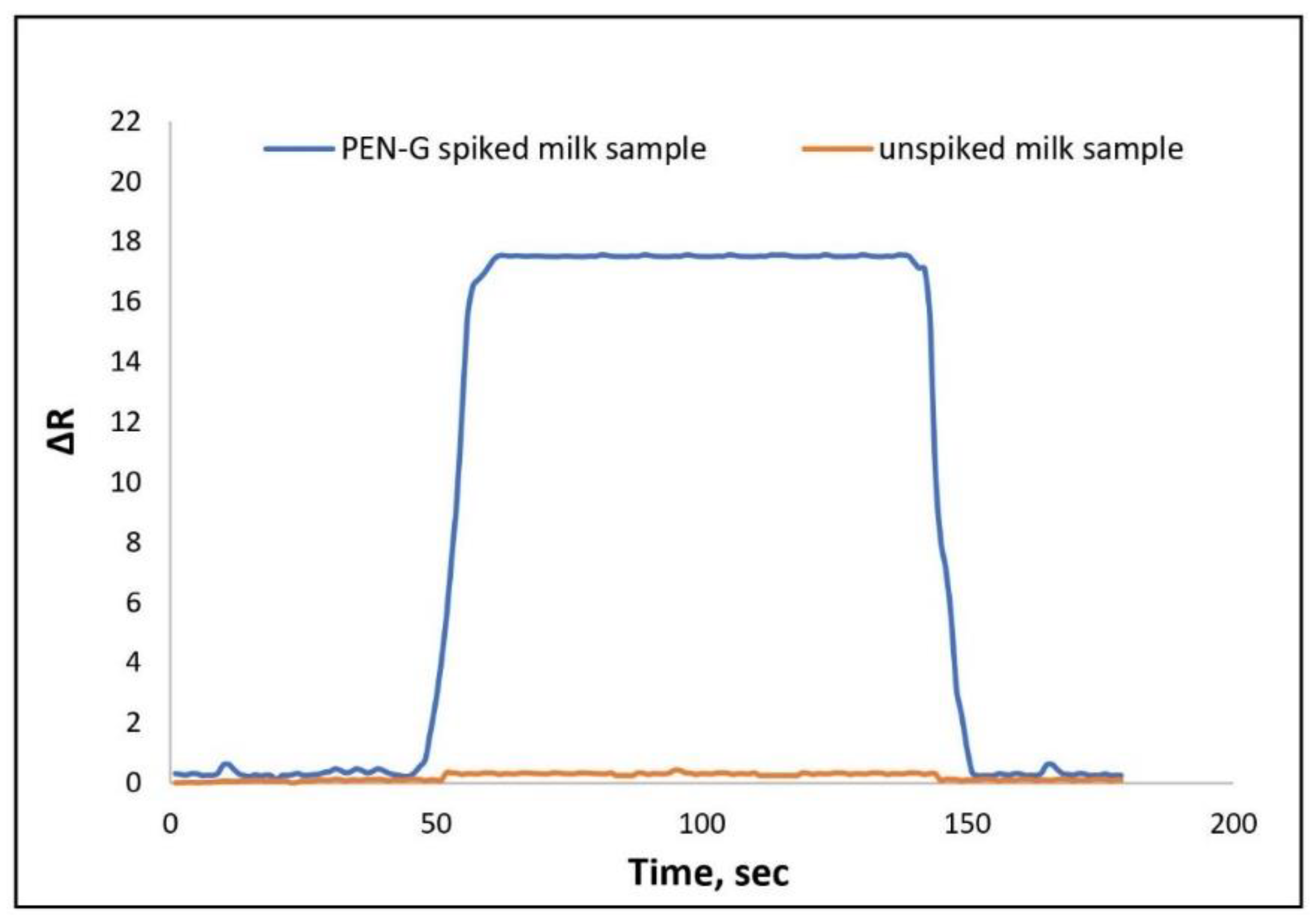
| Equilibrium Analysis (Scatchard) | Association Kinetics Analysis | ||
|---|---|---|---|
| ΔRmax | 14.45 | ka, (ng·mL−1)−1·s−1 | 0.12 |
| KA, (ng·mL−1)−1 | 22.21 | kd, s−1 | 0.01 |
| KD, ng·mL−1 | 0.045 | KA, (ng·mL−1)−1 | 1.013 |
| R2 | 0.93 | KD, ng·mL−1 | 0.10 |
| - | - | R2 | 0.97 |
| Langmiur | Freundlich | Langmiur-Freundlich | |||
|---|---|---|---|---|---|
| ΔRmax | 16.66 | ΔRmax | 11.2 | ΔRmax | 16.1 |
| KA, (ng·mL−1)−1 | 1.5 | 1/n | 0.29 | KA, (ng·mL−1)−1 | 0.39 |
| KD, ng·mL−1 | 0.67 | R2 | 0.98 | KD, ng·mL−1 | 2.52 |
| R2 | 0.99 | - | - | R2 | 0.95 |
| NpMIPs | NpNIPs | ||||
|---|---|---|---|---|---|
| - | ΔR | k | ΔR | k | K’ |
| PEN-G | 16.31 | - | 1.12 | - | - |
| AMX | 0.30 | 54.3 | 0.37 | 3.027 | 17.93 |
| AMP | 0.99 | 16.47 | 0.53 | 2.11 | 7.805 |
Publisher’s Note: MDPI stays neutral with regard to jurisdictional claims in published maps and institutional affiliations. |
© 2021 by the authors. Licensee MDPI, Basel, Switzerland. This article is an open access article distributed under the terms and conditions of the Creative Commons Attribution (CC BY) license (https://creativecommons.org/licenses/by/4.0/).
Share and Cite
Bakhshpour, M.; Göktürk, I.; Bereli, N.; Yılmaz, F.; Denizli, A. Selective Detection of Penicillin G Antibiotic in Milk by Molecularly Imprinted Polymer-Based Plasmonic SPR Sensor. Biomimetics 2021, 6, 72. https://doi.org/10.3390/biomimetics6040072
Bakhshpour M, Göktürk I, Bereli N, Yılmaz F, Denizli A. Selective Detection of Penicillin G Antibiotic in Milk by Molecularly Imprinted Polymer-Based Plasmonic SPR Sensor. Biomimetics. 2021; 6(4):72. https://doi.org/10.3390/biomimetics6040072
Chicago/Turabian StyleBakhshpour, Monireh, Ilgım Göktürk, Nilay Bereli, Fatma Yılmaz, and Adil Denizli. 2021. "Selective Detection of Penicillin G Antibiotic in Milk by Molecularly Imprinted Polymer-Based Plasmonic SPR Sensor" Biomimetics 6, no. 4: 72. https://doi.org/10.3390/biomimetics6040072
APA StyleBakhshpour, M., Göktürk, I., Bereli, N., Yılmaz, F., & Denizli, A. (2021). Selective Detection of Penicillin G Antibiotic in Milk by Molecularly Imprinted Polymer-Based Plasmonic SPR Sensor. Biomimetics, 6(4), 72. https://doi.org/10.3390/biomimetics6040072








